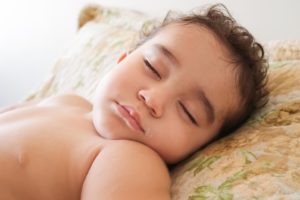Just talking about lice already makes your head itch, right? But lice are a part of every child’s life, even those whose parents are very careful. But what about babies—can babies get lice too? Is it possible for a baby to catch lice? Actually, lice in babies is quite uncommon, but we should warn that it’s not impossible. It’s even more likely for those with lots of hair and who have direct contact with other children who can easily have them. It can happen with those who have older siblings that go to school or even those who already attend daycare or nursery, where there are older children who can pass lice to one another1.
Signs of Lice in Babies
Since babies can’t talk or express what they’re feeling, it can be a little more difficult to identify, so it’s good to be alert for signs. A very typical sign of lice in a baby is a slight flaking in the area of the nape and behind the ears and obviously unexplained irritability, often trying to scratch their head by rubbing it on the pillow. When these signs are identified, it’s worth taking a good look at the baby’s head. Since their hair strands are usually fine, it’ll be easy to spot, if there are any. When lice are present, the baby’s scalp may become reddened and the scalp irritated.
Ways to Prevent Babies from Getting Lice
The only way to prevent babies and children from getting lice is to inspect your child’s head frequently, and if there’s any alert from the daycare or school about an outbreak of lice, pay extra attention. If any family member gets lice, it is recommended to check the hair of all other household members, including mom and dad, to rule out spreading. There isn’t really a specific season when lice start to appear more intensely, even though it may seem, in colder weather, that they start to spread more. In truth, during colder months, children and babies tend to huddle together, closer no matter where they are, which increases the risk of passing lice to each other. This also includes viral and respiratory diseases that increase during this time of the year.
How to Get Rid of Lice in Babies?
To get rid of lice in babies, you need a lot of care and patience, since not all products are suitable for them. With the help of a specific lice comb, commonly called a fine-toothed comb, separate small sections of hair. Try to do this cleaning in a well-lit area where it’s easy to see the lice and nits attached to the strands. A good option are fine combs that come with a magnifying glass to help you see better during the cleaning process. This cleaning should be done carefully and daily until you’re sure that all lice and nits have been removed. Since we’re talking about a baby, they may get impatient with the motion of combing, so do it gently to avoid hurting them and, if possible. If you have a very restless baby who doesn’t keep still for cleaning, try doing it during their nap, laying them in a well-lit spot to make the process easier. You’ll need to sterilize and clean the baby’s pillow, sheets, and crib to eliminate any lice that may have fallen onto them. It’s advised to wash all the baby’s clothes and areas where they usually stay, to stop the spread of lice. Lice infestations do not cause serious problems in babies, even though it’s very unlikely to happen. However, in older children, there is a risk of infection by fungi, viruses, or bacteria due to possible wounds left by the lice and, also, from desperately scratching their heads. If not treated, these can spread and even lead to more serious problems2. It’s important to point out to those unaware that lice does not mean a lack of hygiene! The insect can affect anyone, from any social class and even at any age. It has no connection with hygiene habits. Parents can wash their child’s and baby’s hair every day and, still, they can get lice, because infestation happens through contact with infected people or by sharing objects from someone who has lice. 
Medications for Lice in Babies
For treating lice in babies, great caution is required, as most medications are completely restricted for babies because they contain very strong and harmful substances for their health. Never use any medication, shampoo, or lotion—even if it seems harmless on the pharmacy shelves—without a pediatrician’s recommendation and prescription. The first symptoms may appear 6 to 10 days after exposure to lice or contact with an infected person. After 2 years of age, treatment is usually topical, or even oral, depending on the level of infestation and the child’s weight. Besides the medications prescribed by the pediatrician in some cases, the doctor also recommends using the fine-toothed comb every day, gently and carefully on your baby’s hair. Cutting the hair, which was very common in the past to solve lice infestation, is no longer necessary.











